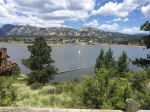 One of the highlights of my recent cross-country road trip was Estes Park, gateway to Rocky Mountain National Park. And how could it not be a highlight? Here is scenery that both inspires and excites in a corner of Colorado once called the ‘Switzerland of America.’ One of several wide valleys at around 8,000 feet, which include North Park, Middle Park, South Park, and Winter Park,
One of the highlights of my recent cross-country road trip was Estes Park, gateway to Rocky Mountain National Park. And how could it not be a highlight? Here is scenery that both inspires and excites in a corner of Colorado once called the ‘Switzerland of America.’ One of several wide valleys at around 8,000 feet, which include North Park, Middle Park, South Park, and Winter Park, 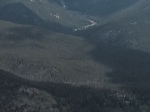 Estes Park itself was renowned for its beauty. But for the long line of British aristocrats that visited the area from the early 1800s, it held a hint of their own landscaped reserves surrounding country estates, yet was a formidable hunting ground, brimming with wildlife they would not encounter back home. No wonder then, given the immense wealth of these visitors, they would want to have it for their own. And one man set out to do just that.
Estes Park itself was renowned for its beauty. But for the long line of British aristocrats that visited the area from the early 1800s, it held a hint of their own landscaped reserves surrounding country estates, yet was a formidable hunting ground, brimming with wildlife they would not encounter back home. No wonder then, given the immense wealth of these visitors, they would want to have it for their own. And one man set out to do just that.
 Windham Thomas Wyndham-Quin, 4th Earl of Dunraven and Mount-Earl, an Anglo-Irish peer, first viewed the Rockies in 1869, aged twenty-eight and on his honeymoon. He had gone to Oxford and served in the Queen’s Life Guards. Best known for being a journalist, writing articles on travel and hunting, he was generally considered an enlightened and rather progressive man for his background, and mixed socially with writers, actors and musicians. His boyhood had been spent reading the western novels of Mayne Reid and Fennimore Cooper so that, despite having a young bride in tow, he now aimed to travel west and hunt. Circumstances conspired against him that year, however, and his party reached only as far as Denver. The dramatic backdrop to this burgeoning town was enough to enthrall him. In the next sixteen years, Dunraven was to travel annually to the west, sometimes more than once a year. After all, Denver was ‘only’ seventeen days from Liverpool.
Windham Thomas Wyndham-Quin, 4th Earl of Dunraven and Mount-Earl, an Anglo-Irish peer, first viewed the Rockies in 1869, aged twenty-eight and on his honeymoon. He had gone to Oxford and served in the Queen’s Life Guards. Best known for being a journalist, writing articles on travel and hunting, he was generally considered an enlightened and rather progressive man for his background, and mixed socially with writers, actors and musicians. His boyhood had been spent reading the western novels of Mayne Reid and Fennimore Cooper so that, despite having a young bride in tow, he now aimed to travel west and hunt. Circumstances conspired against him that year, however, and his party reached only as far as Denver. The dramatic backdrop to this burgeoning town was enough to enthrall him. In the next sixteen years, Dunraven was to travel annually to the west, sometimes more than once a year. After all, Denver was ‘only’ seventeen days from Liverpool.
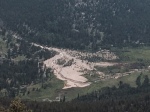 Estes Park had been home to Arapaho and Ute and occasional Apaches. Trappers had passed through, and Missourian Joel Estes came in 1859 to try his hand at ranching there. Griff Evans arrived in 1867 and built cabins to accommodate tourists and lead hunting trips. In 1872, Dunraven finally set eyes on the area for the first time. He had inherited title just a year earlier, and now commanded his family’s extensive fortune, including banks, railroads, shipping and coal, as well as four mansions scattered throughout the British Isles. Having hunted throughout the west on visits over the last three years—including one hunt led by William Cody and his pal, Texas Jack— Dunraven now stayed at one of Evans’ cabins for three weeks and subsequently set his heart on having the park for his private hunting ground. The earl had caught ‘prairie fever’ as Mayne Reid had called it.
Estes Park had been home to Arapaho and Ute and occasional Apaches. Trappers had passed through, and Missourian Joel Estes came in 1859 to try his hand at ranching there. Griff Evans arrived in 1867 and built cabins to accommodate tourists and lead hunting trips. In 1872, Dunraven finally set eyes on the area for the first time. He had inherited title just a year earlier, and now commanded his family’s extensive fortune, including banks, railroads, shipping and coal, as well as four mansions scattered throughout the British Isles. Having hunted throughout the west on visits over the last three years—including one hunt led by William Cody and his pal, Texas Jack— Dunraven now stayed at one of Evans’ cabins for three weeks and subsequently set his heart on having the park for his private hunting ground. The earl had caught ‘prairie fever’ as Mayne Reid had called it.
Why Dunraven favored Estes Park came down to several details, as varied as the beautiful sunsets, the dry air, and the fact nearby Denver was a station for no less than five railroad lines. He loved the area so much that he paid Albert Bierstadt $15,000 for a painting of Estes Park, the first of many he would take home to remind him of his place in the west. The way Dunraven set about obtaining ownership to six thousand acres was a modus operandi that would be employed by numerous ranchers throughout the west in the coming years. Exercising his vast resources, he had his agents bribe various American citizens to make use of both the Pre-emption Act and Homestead Act to either buy or prove up 160 acres each. By choosing the sites wisely, Dunraven enclosed more acreage without access to water. Thirty-one claims were filed for his use.
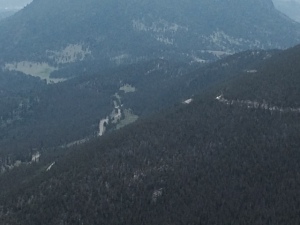 But such a land grab could not go unnoticed. Squatters moved in, and a grand jury was set to investigate his claims. While none of this came to anything, and Dunraven kept his land titles, the harassment showed him the writing on the wall. He had the roads improved and built a hotel as well as a sawmill. Back home in Britain, he was increasingly involved in politics, and would later serve in Her Majesty’s government under Lord Salisbury, as well as in the Senate of the Irish Free State. The Earl made his last visit to Estes Park in 1882, but it was not until 1908 that he sold his land to F.O. Stanley and B. D. Sanborn. Stanley, of course, built the now-historic Stanley Hotel. Rocky Mountain National Park was signed into being in 1915.
But such a land grab could not go unnoticed. Squatters moved in, and a grand jury was set to investigate his claims. While none of this came to anything, and Dunraven kept his land titles, the harassment showed him the writing on the wall. He had the roads improved and built a hotel as well as a sawmill. Back home in Britain, he was increasingly involved in politics, and would later serve in Her Majesty’s government under Lord Salisbury, as well as in the Senate of the Irish Free State. The Earl made his last visit to Estes Park in 1882, but it was not until 1908 that he sold his land to F.O. Stanley and B. D. Sanborn. Stanley, of course, built the now-historic Stanley Hotel. Rocky Mountain National Park was signed into being in 1915.
It is a strange anomaly that a man who wrote approvingly about the preservation of Yellowstone as a national park for the enjoyment of the general public, and later would be instrumental in passing the Irish Land Purchase Act of 1903 (permitting tenants to purchase land with favorable terms from their landlords), should want to illegally secure such a large swathe of American countryside. But Dunraven was very much a product of his background, if an enlightened one, and only the first of many Brits who would seek to use the west for their own profit and enjoyment.
My first book, Loveland, deals with this in part. It is to be re-released by Amazon Encore on Sept. 15th.
Photograph of Lord Dunraven in public domain. All other photos Cristal Downing and myself.

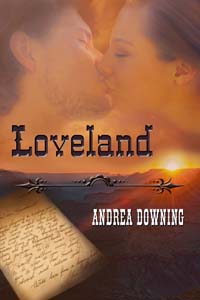


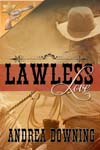












Hmmm? Seems Dunraven was not and won’t be the last Brit to appreciate America’s beauty and allure. Winking at you, Andi.
LikeLike
Well, wink away, but remember please I’m American! Thanks for stopping by, Karen 😉
LikeLike
Interesting, Andi. I love Estes Park and various other parts of Colorado. We spent a lot of summer vacations in Colorado. We went back to Montana the first year after moving to Kansas, but after that, it was about every five years. A couple of times we varied with a trip to Branson and one to Texas, but most years we vacationed in Colorado. Also loved Idaho Springs, Georgetown, Evergreen, Central City before the casinos (hated they messed it up with casinos.) Also enjoyed Denver and Golden and Boulder, and Loveland, and the list goes on. One delightful summer vacation was spent in Nederland in a small cabin. Friends from Denver came up and we went purple glass hunting. Yep! We’ve lots of fond memories of Colorado.
LikeLike
Ah, who couldn’t love Colorado? Maybe they should call Switzerland ‘The Colorado of Europe” rather than the other way around!
LikeLike
Thank you for this, Andi. I had no idea there was a little Switzerland in America. And what beauty. I’m happy you shared this with us.
LikeLike
Yes, the tag of being the ‘Switzerland of America’ for Colorado did amuse me. Quite honestly, I think Colorado outshines Switzerland any day. Thanks for stopping by.
LikeLike
I haven’t been to Estes Park, but I’ve been to the Canadian Rockies. Wherever they are, the Rockies are awe inspiring!
LikeLike
I agree. In fact, I believe I was up in the Canadian Rockies before I got to Colorado and the US Rockies. Visited Calgary, Banff, Lake Louise when I was 15, then headed down to Yellowstone. Such a fabulous area of both countries. Nowadays I’m lucky enough to have a place in Wyoming 5 miles from Grand Teton NP.
LikeLike
Hi, Andrea! I visit Colorado at least once a year and am always captivated. I love driving the back roads which lead to hot springs, abandoned gold camps, fighting bison. But I’ve not head the Little Switzerland part. I visited Lucern this past summer and loved it.
LikeLike
I wonder if you’ve ever driven the road that goes from Estes Park through Rocky Mt. NP to Steamboat Springs? If not, believe me, it is one of the great USA drives with spectacular scenery, wildlife and breathtaking views. And then there’s always a fine lunch and walk around to be taken in Steamboat Springs!
LikeLike
Fascinating history. Thank you for sharing : )
LikeLike
You’re very welcome. And thank you for stopping by.
LikeLike
Intriguing story! I visited Estes Park many years ago, and loved everything I saw there. No wonder Dunraven wanted it for himself! Not all that different from Vanderbilt, who once owned 100,000 acres in Western NC, I guess.
LikeLike
Ah, yes, the Biltmore Estate. I guess when you have that much money, you can contemplate such land grabs.
LikeLike
Interesting history lesson about one of the nation’s most beautiful parks. My husband and I visited there some years ago. thanks for sharing.
LikeLike
It is, indeed,one of the nation’s most beautiful parks–the NATION’S being an important point here. I hope you get back again.
LikeLike
Love the story, Andrea. Thank for telling us about it!
LikeLike
You’re very welcome. Thanks for taking the time to stop by.
LikeLike
Interesting post, Andi! I’ve only been to Colorado once and I’m dying to go back. It is definitely an inspiration!
LikeLike
An inspiration, indeed. It’s the setting for my book Loveland–the town is at the start of the road leading into Estes Park from the east. That’s a really lovely drive, as well as going out westwards to Steamboat Springs.
LikeLike
Great blog, Andi. The drive out of Estes Park into the mountains is truly amazing and can leave you breathless and not just from the altitude! It’s doubly great in the fall when the Aspen leaves are turning gold.
LikeLike
Ah, you’ve made me jealous, Rebecca. I’ll definitely have to try to get down there in the autumn one year.
LikeLike
Estes Park is practically in my back yard. I live in Longmont, about 24 miles away. I spend one weekend a month in Estes Park and have a yearly pass to Rocky Mountain National Park. It wasn’t greed that drove him to want to buy up the area. It was the sheer beauty of it all. The sheer wonder and awe and I can’t even describe it. When I am up there, I feel like I am home. I can’t blame him a bit!
LikeLike
Well, Susabelle, you wouldn’t be able to enjoy it if Dunraven had held on to it. In those days, no one really thought ahead this far and condemned him for buying it; it was the way he went about it. Those who made claims under the Homestead Act were supposed to live on the land to ‘prove up’ as it was called. None of them did; they took bribes from Dunraven and handed over the titles. I did a couple of book signings in Loveland and must say I envy y’all who live so near to Estes Park. My daughter and I certainly enjoyed our visit greatly.
LikeLike
Had Dunraven not held on to his land as long as he did, Estes would be even more populated and hacked up than it is today. You did a very good job on proper Dunraven history and thank you for not butchering him, it is sport here but most all lies. He is blamed for hunting the Elk to extinction but they were extinct in 1913, 30 years after his departure. He did not own brothels and never did the evil things at The Stanley Hotel he is accused of either , it was built in 1909. While he wanted it selfishly for himself and his friends he wanted to maintain the beauty. I own Dunravens Cottage in Estes Park, built in 1876. Please keep up the good work and visit us next time you are in Estes.
LikeLike
Thank you so much for adding to this discussion. I think you are absolutely right in saying what is now Rocky Mt. NP would have been decimated had Dunraven not held onto the land for as long as he did. I have never, however, heard any of the accusations you mention regarding Elk, brothels, etc. Perhaps they are local? The only criticisms I have ever seen leveled at Dunraven regard the way he went about obtaining his land, which, of course, are true, as I described in the piece. I’m excited to learn that his cottage still stands and would certainly like to see it sometime. Thanks again for stopping by.
LikeLike